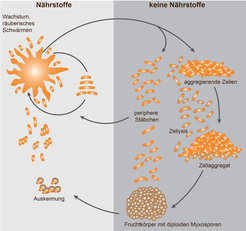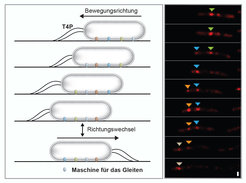Myxococcus xanthus: Microbe of the Year 2020
Each year, the Association for General and Applied Microbiology (VAAM) chooses a special bacterium to draw attention to the diversity of the microbial world. This year's winner is Myxococcus xanthus. This extremely fascinating bacterium is a research focus of our Department of Ecophysiology led by Prof. Lotte Søgaard-Andersen.

Myxobacteria have developed a community lifestyle that is quite unusual for microbes. The rod-shaped bacteria live in species-specific colonies and interact with each other during their entire life cycle. For this reason they are often referred to as "social" bacteria. Their Latin name already reveals much of their appearance: their mucus (myxa) holds them together as a colony; coccus describes their spherical myxospores, and xanthos refers to the yellow colour of the vegetative colonies and their perhaps most striking feature, the fruiting bodies.
Predators and Cannibals
M. xanthus lives in the soil on plant debris and dung, where they form predatory swarms that engulf and decompose other microorganisms. To this end, they excrete numerous metabolites, including secondary metabolites with antimicrobial activity. Therefore, pharmaceutical research is also interested in the bacterium in regard to finding new therapeutics.
Interestingly, M. xanthus not only kills bacteria of other species, but also may act as a cannibal: the microbe is able to kill less fit individuals within its own population, using a sophisticated injection device that is widely used among bacteria. It protrudes from the cell envelope, can suddenly pierce the cell wall of the victim and inject toxins. The elimination of weaker members of a colony probably have the purpose of ensuring homogeneity; a property that could be important for the successful collective behaviour of M. xanthus.
Cooperative survival artist
In response to starvation, and when the colony has reached a sufficiently high cell density, 100,000 and more cells flow towards each other to form a fruiting body (Fig 1). In some species of Myxobacteria, this fruiting body can take the form of a small tree and reach 0.7 millimeters in size; those can be easily detected with a magnifying glass. In M. xanthus, the spherical fruiting body reaches a diameter of about 0.08 millimeters - almost the thickness of a sheet of paper. Prerequisite for this is a sufficiently high cell density.

Fig. 2: The life cycle of Myococcus xanthus is characterised by social behavior. In the presence of nutrients (left, light grey), the mobile rod-shaped cells grow and divide and form predatory cell swarms. In contrast, in the absence of nutrients (right, dark grey) a differentiation program is initiated in the course of which about ten percent of the initially hungry population differentiates into myxospores within the fruiting bodies (brown spore clusters). Approximately 30 percent form metabolically active individuals outside the fruiting body (peripheral rods), and the rest of the population is lysed. The fruiting body is formed by aggregation of starving cells, connected by intercellular communication. In the presence of nutrients, the spores germinate and form metabolically active vegetative cells. The joint germination of the spores allows the immediate formation of multicellular predator swarms.
Remarkably not all individuals behave in the same way: About ten percent change into a spore. About 30 percent become metabolically active individuals outside the fruiting body (peripheral rods). The majority of the population dies off and serves as a source of nutrients for the rest of the colony. Spore formation takes place only within the fruiting body and ingeniously combines survival with cooperation: as soon as conditions have improved, a joint germination of spores allows the immediate formation of a multi-cellular hunting flock.
In our group, we are studying the processes associated with these different life phases down to the molecular detail. This includes changes in gene expression, intracellular signal processing, communication between bacteria and their coordination of cell movements and cell cycle (Fig. 2).
Versatile Motion Talent

Mobility is essential for both life phases of Myxococcus. M. xanthus has two forms of movement: traction and sliding. For the twitching movement, the motility system assembles at the front cell pole and forms cellular extensions (pili) that can adhere to surfaces. By lengthening, adhering and then shortening again, the pili pull the cells forward. This form of movement and the associated cell-cell contacts enable the bacterium to form cell associations. The machinery for the sliding movement consists of three to four protein complexes, which are assemble at the anterior pole but are lined up along the longitudinal axis of the cell. They protrude through the cell envelope and adhere to the surface of the substrate. The active protein complexes then move to the rear pole via a still unknown mechanism, their attachment pushing the cell forward (Fig. 3). This movement mechanism also allows individual cells to move independently of each other.
Complex behavior requires complex cell functions
Occasionally, the cells change their direction of movement: now the previously front pole becomes the new rear pole. Both motility systems change their polarity synchronously to ensure forward movement in the opposite direction, and both of them can theoretically assemble and be combined at both poles. However, the fact that this only occurs at the respective front pole is the result of a complex regulation mechanism. The center of this regulation process is a control protein which is mainly known from eukaryotes. Since the change of direction is essential for hunting as well as for the formation of fruiting bodies, the analysis of the function, interaction and localization of these control protein is a central part of our current research. The different facets of the "social bacterium" are being investigated on many levels and often reveal surprising details. Research beyond the classical bacterial model species is worthwhile!














